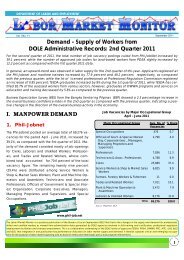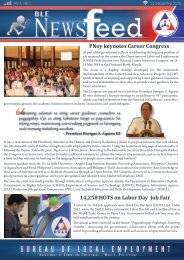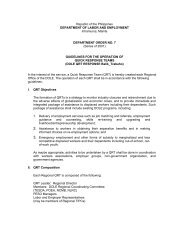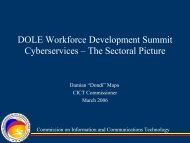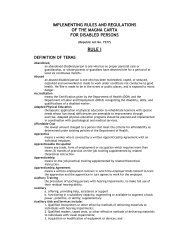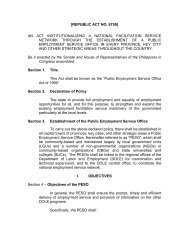towards an achievable manpower action plan for the philippine
towards an achievable manpower action plan for the philippine
towards an achievable manpower action plan for the philippine
Create successful ePaper yourself
Turn your PDF publications into a flip-book with our unique Google optimized e-Paper software.
TOWARDS AN ACHIEVABLE MANPOWER ACTION PLAN FOR<br />
THE PHILIPPINE MINING INDUSTRY<br />
Nelia C. Halcon<br />
Executive Vice President<br />
Chamber of Mines of <strong>the</strong> Philippines<br />
Profile of <strong>the</strong> Mining Industry<br />
A Brief History<br />
Sp<strong>an</strong>ning more th<strong>an</strong> a hundred years, <strong>an</strong>d even be<strong>for</strong>e<br />
<strong>the</strong> war, <strong>the</strong> Philippine mining industry was already<br />
composed of about 40 large scale mining projects mostly<br />
operated by <strong>the</strong> Americ<strong>an</strong>s.<br />
Mining was pursued as <strong>the</strong> industry of <strong>the</strong> 70s with <strong>the</strong><br />
promulgation of PD. No. 463 to fast track <strong>the</strong> processing of<br />
claims <strong>an</strong>d <strong>the</strong> development of mining projects. With <strong>the</strong><br />
medium <strong>an</strong>d long-term pl<strong>an</strong> <strong>an</strong>chored on mineral-based<br />
industries such as <strong>the</strong> 11 major industrial projects, mining<br />
posted a high rate of growth from 1971 to 1981 <strong>an</strong>d with 45<br />
mines operating; <strong>the</strong>ir combined output contributed 21% of<br />
<strong>the</strong> country’s total export earnings in <strong>the</strong> 1980s.<br />
A number of factors, however, caused <strong>the</strong> decline of<br />
<strong>the</strong> industry in later years. From <strong>the</strong> oil crisis to heavy<br />
taxation compounded by <strong>the</strong> decline in world market prices,<br />
<strong>the</strong> industry became saddled with debt burdens that later<br />
made some operations uneconomical leading to mine<br />
closures.<br />
Except <strong>for</strong> a brief boom in 1988-89, <strong>the</strong> mining<br />
industry struggled through <strong>the</strong> 1990s <strong>an</strong>d was given <strong>the</strong><br />
necessary boost with <strong>the</strong> promulgation of <strong>the</strong> Mining Act of<br />
1995. Subsequent events such as <strong>the</strong> Marcopper incident,<br />
<strong>the</strong> constitutional challenge to <strong>the</strong> Mining Law <strong>an</strong>d <strong>the</strong><br />
passage of <strong>the</strong> IPRA along with <strong>the</strong> increasing complexities<br />
of issues prevented <strong>the</strong> industry from moving <strong>for</strong>ward. The<br />
20% export receipts during <strong>the</strong> boom years went down to<br />
only 2% in 2003 with barely 7 mines operating, down from<br />
<strong>the</strong> previous 45. The industry’s downtrend was<br />
compounded by <strong>the</strong> ambivalent policy of <strong>the</strong> national<br />
government <strong>towards</strong> mining in previous years. The<br />
emergence of advocacy groups against mining in view of<br />
1
issues r<strong>an</strong>ging from <strong>for</strong>eign investments, environmental<br />
problems, <strong>an</strong>d indigenous peoples concerns, brought to <strong>the</strong><br />
<strong>for</strong>e <strong>the</strong> m<strong>an</strong>y challenges facing <strong>the</strong> industry.<br />
With <strong>the</strong> government <strong>an</strong>d private sector ef<strong>for</strong>ts to<br />
revitalize mining particularly after <strong>the</strong> constitutionality of<br />
<strong>the</strong> Mining Act was upheld by <strong>the</strong> Supreme Court, a strong<br />
sentiment that mining may well become <strong>the</strong> driver of<br />
economic growth in <strong>the</strong> country has made government to<br />
capitalize on its strong opportunities.<br />
Current Developments<br />
Early last year after <strong>the</strong> Supreme Court ruled with<br />
finality <strong>the</strong> constitutionality of <strong>the</strong> Mining Act., <strong>the</strong> Chamber<br />
of Mines in close coordination with government conducted<br />
<strong>an</strong> International Mining Investment Conference in February,<br />
<strong>the</strong> main objective of which was to in<strong>for</strong>m <strong>the</strong> international<br />
mining community that <strong>the</strong> industry is “open <strong>for</strong> business”,<br />
<strong>an</strong>d that mining investors c<strong>an</strong> now invest in a number of<br />
mining projects. Various road shows were also made in<br />
several countries culminating into <strong>the</strong> 6 th Asia Pacific Mining<br />
Conference in October, 2005 with no less th<strong>an</strong> <strong>the</strong> President,<br />
tendering a dinner reception <strong>for</strong> <strong>the</strong> mining particip<strong>an</strong>ts.<br />
Be<strong>for</strong>e <strong>the</strong> end of <strong>the</strong> year, <strong>the</strong> government recorded<br />
investment inflows of close to US$ 500 million <strong>an</strong>d a job<br />
generation of 5,000. It has targeted a turnover of US 5<br />
billion in 2006 with a corresponding 50,000 jobs <strong>an</strong>d US$6.5<br />
billion over <strong>the</strong> next five years.<br />
In 2005, <strong>the</strong> mining industry was able to sustain its<br />
growth momentum with nickel providing <strong>the</strong> biggest<br />
contribution aside from crude oil. Domestic production of<br />
gold, copper <strong>an</strong>d chromite leaped to a robust growth in<br />
terms of value as prices of major minerals soared in <strong>the</strong><br />
world market.<br />
The mining industry is composed of about 2,311 or<br />
more mining enterprises, broken down as follows.<br />
2 large-scale gold mines<br />
- Victoria Gold Project (Lep<strong>an</strong>to Consolidated<br />
Mining Corporation)<br />
- Teresa Gold Projects (Lep<strong>an</strong>to Consolidated<br />
Mining Corporation)<br />
2
• 1 large-scale copper mine<br />
- Padcal Copper Project (Philex Mining<br />
Corporation);<br />
• 4 medium-scale nickel mines<br />
- Palaw<strong>an</strong> Nickel Project (Rio Tuba Mining<br />
Corporation)<br />
- Cagdi<strong>an</strong>ao Nickel Project (Cagdi<strong>an</strong>ao Mining<br />
Corporation)<br />
- South Dinagat Nickel Project (Hinatu<strong>an</strong> Mining<br />
Corporation)<br />
- Tag<strong>an</strong>ito Nickel Project ( Tag<strong>an</strong>ito Mining<br />
Corporation)<br />
• 4 medium-scale chromite mines<br />
- Masinloc Chromite Project (Benguet<br />
Corporation)<br />
- Omasd<strong>an</strong>g Chromite Project (Crau Minerals)<br />
- Homonhon chhomite Project (Heritage<br />
Resources Mining Corp.)<br />
- Dinagat Chromite Project (Krominco.)<br />
• 4 medium-scale gold mines<br />
- C<strong>an</strong>atu<strong>an</strong> Silver-Gold Project (TVI Resources<br />
Philippines, Inc.)<br />
- Acup<strong>an</strong> SSM Operations (Benguet Corporation)<br />
- Diwalwal Direct State Development Project<br />
(NRMDC)<br />
- B<strong>an</strong>ahaw Gold Project ( Philsaga Mining Corp.)<br />
• 16 cement pl<strong>an</strong>ts <strong>an</strong>d quarries<br />
• 127 limestone <strong>an</strong>d slaked lime producers<br />
• 93 rock aggregate quarries <strong>an</strong>d crushing<br />
pl<strong>an</strong>ts<br />
• 184 industrial s<strong>an</strong>d <strong>an</strong>d gravel quarries <strong>an</strong>d<br />
crushing pl<strong>an</strong>ts<br />
• 9 marble pl<strong>an</strong>ts <strong>an</strong>d quarries<br />
• 1,871 quarries <strong>an</strong>d small scale mines of<br />
covered by permits issued by local<br />
government.<br />
During <strong>the</strong> first five months of 2005, trading value in<br />
<strong>the</strong> Philippine Stock Exch<strong>an</strong>ge ballooned by 162% to P196.5<br />
billion from P74.9 billion in 2004. The liquid per<strong>for</strong>m<strong>an</strong>ce of<br />
<strong>the</strong> market is attributed to <strong>the</strong> optimistic macroeconomic<br />
indicators such as GDP growth, rise in private consumption,<br />
increase in exports <strong>an</strong>d <strong>the</strong> implementation of key fiscal<br />
measures. Towards <strong>the</strong> end of <strong>the</strong> year, <strong>the</strong> mining sector’s<br />
impressive growth became more visible as it cornered<br />
53.6% of total trading volume, retaining its position as <strong>the</strong><br />
3
est per<strong>for</strong>ming sector, followed by <strong>the</strong> oil sector. Foreign<br />
investors accounted <strong>for</strong> more th<strong>an</strong> 50% of <strong>the</strong> market<br />
turnover, <strong>an</strong> indication of <strong>the</strong> attention given to economic<br />
fundamentals ra<strong>the</strong>r th<strong>an</strong> <strong>the</strong> political troubles.<br />
These developments validate <strong>the</strong> Washington D.C.-<br />
based Institute of International Fin<strong>an</strong>ce r<strong>an</strong>king <strong>the</strong><br />
Philippines’ investor relations program number one in its<br />
assessment of <strong>the</strong> investor relations activities of 30<br />
emerging economies. In November 2005, <strong>the</strong> Philippines<br />
also received <strong>the</strong> Mining Journal Country Award <strong>for</strong> showing<br />
<strong>the</strong> most improvement in terms of attractiveness to mineral<br />
investors during 2004-2005.<br />
Barely a year after promoting <strong>the</strong> 24 priority mining<br />
projects <strong>an</strong>d considering <strong>the</strong> long lead time of putting a<br />
mine into operations, four (4) of <strong>the</strong> 24 projects are already<br />
in <strong>the</strong>ir production stage, namely: Coral Bay Nickel<br />
Processing, Teresa of Lep<strong>an</strong>to, TVI C<strong>an</strong>atu<strong>an</strong> <strong>an</strong>d Rapu Rapu<br />
of Lafayette.<br />
In all, <strong>the</strong> Philippine mining industry per<strong>for</strong>med<br />
exceptionally well in 2005 based on its per<strong>for</strong>m<strong>an</strong>ce in <strong>the</strong><br />
stock market, investments, GDP contribution, exports,<br />
employment generation not to mention <strong>the</strong> multiplier effects<br />
that mining operations bring in <strong>the</strong> communities hosting <strong>the</strong><br />
mine sites.<br />
Outlook <strong>for</strong> 2006 <strong>an</strong>d Beyond<br />
• The mining industry will continue to enjoy a seller’s<br />
market in 2006 fuelled by <strong>the</strong> continuing increase in<br />
dem<strong>an</strong>d that has been driving prices into all time highs.<br />
• With a third of <strong>the</strong> entire archipelago considered<br />
geologically prospective areas <strong>for</strong> metallic minerals, <strong>an</strong>d<br />
with only 1.5% of <strong>the</strong> total l<strong>an</strong>d area covered by<br />
approved mining tenements, <strong>the</strong> likelihood of new<br />
discoveries c<strong>an</strong> be expected during <strong>the</strong> year.<br />
• In terms of production, operating comp<strong>an</strong>ies will take<br />
adv<strong>an</strong>tage of high prices to sustain increasing costs of<br />
operations, particularly in fuel <strong>an</strong>d energy.<br />
4
• Barring <strong>an</strong>y major political instability, investment in <strong>the</strong><br />
industry is expected to rise with <strong>the</strong> strong economic <strong>an</strong>d<br />
market fundamentals. Industry <strong>for</strong>ecast indicate that<br />
total investment in 2006 may reach US$5 billion with a<br />
corresponding job generation of 50,000, <strong>an</strong>d US$6.5<br />
billion over <strong>the</strong> next five years.<br />
• Policy re<strong>for</strong>m implementation will continue to be<br />
monitored to ensure <strong>the</strong> inflow of direct <strong>for</strong>eign<br />
investments or money via <strong>the</strong> local bourse.<br />
• 2006 will continue to be dominated by gold, copper,<br />
nickel <strong>an</strong>d chromite although m<strong>an</strong>g<strong>an</strong>ese <strong>an</strong>d iron ore<br />
being in dem<strong>an</strong>d will resurface into <strong>the</strong> production<br />
stream.<br />
• The construction sector’s boom will impact on <strong>the</strong> nonmetallic<br />
minerals <strong>an</strong>d <strong>the</strong> cement industry. The on-going<br />
construction activities also augur well <strong>for</strong> <strong>the</strong> service<br />
industries <strong>an</strong>d <strong>the</strong> machineries <strong>an</strong>d equipment sector.<br />
• Most indicators give a positive level of optimism <strong>for</strong> 2006<br />
<strong>an</strong>d policy-makers are on guard in maintaining economic<br />
stability <strong>an</strong>d in sustaining <strong>the</strong> momentum <strong>for</strong> growth.<br />
Employment Situation in <strong>the</strong> Mining Industry<br />
The revival of <strong>the</strong> mining industry will have a positive<br />
effect on employment. As experienced in <strong>the</strong> past, increased<br />
exploration activities <strong>an</strong>d <strong>the</strong> development of new projects as<br />
well as <strong>the</strong> exp<strong>an</strong>sion of existing ones bring about a<br />
corresponding increase in employment. Statistics have<br />
indicated this when employment in 1995 of 107,000 went up<br />
to 130,000 in 1997 due to <strong>the</strong> upbeat situation in <strong>the</strong> industry<br />
after <strong>the</strong> passage of <strong>the</strong> Mining Act. The 30,000 employees<br />
were wiped out easily in 1999 after most investors left <strong>the</strong><br />
country due to <strong>the</strong> challenge in <strong>the</strong> mining law, <strong>the</strong> issues<br />
brought about by <strong>the</strong> passage of IPRA <strong>an</strong>d <strong>the</strong><br />
decentralization of government functions.<br />
5
Table 1<br />
Employment in Mining & Quarrying<br />
1995- 2004<br />
________________________________________________<br />
Year<br />
Total Employees<br />
________________________________________________<br />
1995 107,000<br />
1996 113,000<br />
1997 130,000<br />
1998 120,000<br />
1999 100,000<br />
2000 110,000<br />
2001 104,000<br />
2002 101,000<br />
2003 104,000<br />
2004 118,000<br />
2005 125,000*<br />
________________________________________________<br />
*Estimate<br />
Source: DOLE<br />
The percentage share of total employment in <strong>the</strong><br />
mining sector is not signific<strong>an</strong>t owing to its equipmentintensive<br />
nature. Of <strong>the</strong> total employment figures released<br />
by DOLE, it could be safely estimated that only about 10 to<br />
20% are from <strong>the</strong> metallic sector with <strong>the</strong> rest contributed<br />
by <strong>the</strong> non-metallic sector including <strong>the</strong> cement industry.<br />
Although not considered labor intensive, experts in <strong>the</strong> field<br />
say that <strong>for</strong> every job generated in <strong>the</strong> industry, a<br />
corresponding 5 jobs are created in <strong>the</strong> upstream <strong>an</strong>d<br />
downstream activities in <strong>the</strong> sector.<br />
Statistics on deployment by mining engineers,<br />
geologists <strong>an</strong>d o<strong>the</strong>r mining-related profession are hard to<br />
get. What is known is that a number of <strong>the</strong> technical people<br />
employed previously by <strong>the</strong> mining comp<strong>an</strong>ies during its<br />
heydays have found better paying jobs in as far as South<br />
Africa, C<strong>an</strong>ada, <strong>the</strong> United States <strong>an</strong>d South America.<br />
Recently, some well-trained technical personnel have been<br />
taken by new mines operating in <strong>the</strong> neighboring countries<br />
of Indonesia, Malaysia <strong>an</strong>d Vietnam.<br />
6
With respect to <strong>the</strong> terms <strong>an</strong>d conditions of<br />
employment, mining engineers, geologists, metallurgists<br />
<strong>an</strong>d o<strong>the</strong>r related profession employed in <strong>the</strong> mining<br />
industry receive higher compensation in view of <strong>the</strong> nature<br />
of <strong>the</strong>ir jobs. In addition, most if not all receive non-cash<br />
benefits such as housing, electricity <strong>an</strong>d water, with some<br />
giving <strong>the</strong>ir employees stock options.<br />
Dem<strong>an</strong>d <strong>for</strong> M<strong>an</strong>power Resources in Mining<br />
The nature of work in <strong>the</strong> mining industry requires<br />
competence in engineering jobs <strong>an</strong>d skills in terms of <strong>the</strong><br />
requirements of <strong>the</strong> mining operations. Those who have<br />
gained on <strong>the</strong> job experience are normally preferred th<strong>an</strong><br />
those who have not been immersed in actual mining<br />
operations. At present, however, new graduates c<strong>an</strong> be<br />
hired immediately after passing <strong>the</strong> Board examinations <strong>an</strong>d<br />
are given training by <strong>the</strong> comp<strong>an</strong>ies. Age is not too<br />
import<strong>an</strong>t although physical fitness counts. Gender does not<br />
pose problems although most mining comp<strong>an</strong>ies prefer<br />
males over females in view of <strong>the</strong> nature of <strong>the</strong> job.<br />
The dem<strong>an</strong>d <strong>for</strong> m<strong>an</strong>power in <strong>the</strong> mining industry c<strong>an</strong><br />
be gauged by <strong>the</strong> number of active exploration activities<br />
being undertaken all over <strong>the</strong> country, <strong>the</strong> exp<strong>an</strong>sion in<br />
operations by existing comp<strong>an</strong>ies, <strong>the</strong> pl<strong>an</strong>ned operation of<br />
new enterprises as well as <strong>the</strong> re-operation of comp<strong>an</strong>ies<br />
that have closed shop in <strong>the</strong> early 1990s. In <strong>the</strong> nonmetallic<br />
sector, we normally consider <strong>the</strong> trend in <strong>the</strong><br />
construction industry as <strong>an</strong> indicator.<br />
Some of <strong>the</strong> major producing comp<strong>an</strong>ies are alarmed<br />
by <strong>the</strong> resignation of <strong>the</strong>ir trained employees who have<br />
accepted new jobs ei<strong>the</strong>r abroad or in new comp<strong>an</strong>ies that<br />
are now operating in <strong>the</strong> country. In my several years of<br />
work at <strong>the</strong> Chamber of Mines, it was only last year, when I<br />
received several letters from our associates in <strong>the</strong> ASEAN<br />
Federation of Mining Association asking me to recommend<br />
geologists, mining engineers <strong>an</strong>d o<strong>the</strong>r related mining jobs<br />
<strong>for</strong> employment in <strong>the</strong>ir countries or in projects <strong>the</strong>y are<br />
doing elsewhere. Indeed, it c<strong>an</strong> be said that mining is really<br />
back <strong>an</strong>d that mining jobs are currently in dem<strong>an</strong>d that<br />
some mining comp<strong>an</strong>ies are now even posting <strong>the</strong>ir job<br />
requirements in universities offering mining-related courses,<br />
<strong>an</strong>d are willing to train new graduates.<br />
7
Job Prospects in <strong>the</strong> Next 5 Years<br />
Barring <strong>an</strong>y political instability or putting politics aside,<br />
our industry officials have confidently <strong>for</strong>ecast that <strong>for</strong> 2006,<br />
investments may reach US$5 billion with a corresponding<br />
job generation of 50,000 <strong>an</strong>d US$6.5 billion over <strong>the</strong> next 5<br />
years or a job generation of 75,000 more.<br />
Government <strong>for</strong>ecast, on <strong>the</strong> o<strong>the</strong>r h<strong>an</strong>d, based on<br />
projected investments from new <strong>an</strong>d exp<strong>an</strong>sion projects <strong>an</strong>d<br />
considering <strong>the</strong> 24 priority projects indicated <strong>an</strong> increasing<br />
trend as shown in <strong>the</strong> table 2<br />
Table 2<br />
Job Generation Projections From <strong>the</strong> Priority Mining<br />
Projects*<br />
________________________________________________<br />
Year<br />
Projected Jobs<br />
2004 2,716<br />
2005 3,370<br />
2006 5,034<br />
2007 8,020<br />
2008 9,450<br />
2009 8,050<br />
2010 6,900<br />
* Metallic Mines only<br />
Source: Mines <strong>an</strong>d Geo-sciences Bureau/DENR<br />
A snap shot survey conducted among <strong>the</strong> members of<br />
<strong>the</strong> Chamber of Mines indicated that dem<strong>an</strong>d <strong>for</strong> mining jobs<br />
will increase between <strong>the</strong> period from 2006 to 2009 when<br />
some of <strong>the</strong> large ticket projects would have started, up to<br />
2010, tapering off after that year. A lot of requirements will<br />
be coming from <strong>the</strong> production, seasonal <strong>an</strong>d contractual<br />
workers, those that need special skills in mining. This will<br />
pose a serious problem in <strong>the</strong> industry considering that<br />
<strong>the</strong>se workers need to be trained be<strong>for</strong>e <strong>the</strong>y are immersed<br />
in actual mining.<br />
8
The Supply Side<br />
The Professional Regulations Commission (PRC) should<br />
have a complete data on <strong>the</strong> stock of professional mining<br />
engineers, geologists <strong>an</strong>d related professions based on <strong>the</strong><br />
number of professionals passing <strong>the</strong> board examinations.<br />
In late 1990s when <strong>the</strong> industry was almost considered<br />
a sunset industry, several institutions decided not to offer<br />
mining courses. These include St. Louis University in<br />
Baguio, Mapua University <strong>an</strong>d Cebu Institute of Technology.<br />
The number of graduates from universities offering miningrelated<br />
courses does not reflect <strong>the</strong> optimism in <strong>the</strong><br />
industry. This is underst<strong>an</strong>dable considering that it was<br />
only recently when <strong>the</strong> mining industry was given a<br />
predomin<strong>an</strong>t place in government’s programs.<br />
Table 3<br />
No. of Graduates in Mining Related Professions<br />
________________________________________________<br />
Year/Course UP Adamson Mapua Total<br />
2000 /Geo 25 1 6 32<br />
Mng 2 0 8 10<br />
Met 58 58<br />
2001 Geo 19 1 3 23<br />
Mng 2 0 8 10<br />
Met 58 58<br />
2002 Geo 18 2 7 27<br />
Mng 7 0 7 14<br />
Met 48 48<br />
2003 Geo 27 2 4 33<br />
Mng 5 2 4 11<br />
Met 30 30<br />
2004 Geo 16 2 4 22<br />
Mng 4 2 1 7<br />
Met 29 29<br />
2005 Geo 29 2 8 39<br />
Mng 16 0 0 16<br />
Met 37 37<br />
9
Total Graduates Per Year of Mining Related Profession<br />
Year Geologists Mining Eng. Met. Eng.<br />
2000 32 10 58<br />
2001 23 10 58<br />
2002 27 14 48<br />
2003 33 11 30<br />
2004 22 7 28<br />
2005 39 16 37<br />
________________________________________________<br />
Statistics show that <strong>the</strong> mining profession has lost its<br />
luster as a career based on <strong>the</strong> number of graduates<br />
produced during <strong>the</strong> last five years. We do not have to<br />
blame <strong>the</strong> institutions or <strong>the</strong> private mining sector about<br />
this outcome because <strong>the</strong>re exist reasonable reasons why<br />
<strong>the</strong> young generations did not consider mining as a career or<br />
profession. First, <strong>the</strong> environment <strong>for</strong> mining as <strong>an</strong> industry<br />
was per<strong>for</strong>ming dismally since 1997 <strong>an</strong>d it was only after<br />
seven years when government started promoting its<br />
development <strong>an</strong>d revitalization. A strong public opinion<br />
against mining has been relentlessly pursued by advocates<br />
against mining <strong>an</strong>d this had <strong>an</strong> impact on young minds.<br />
Lastly, some academic institutions joined <strong>the</strong> fray against<br />
mining such as Meriam University.<br />
Projections <strong>for</strong> <strong>the</strong> Next 5 Years<br />
It is hard to project <strong>the</strong> number of graduates in<br />
mining-related professions over <strong>the</strong> next 5 years, this being<br />
a function of dem<strong>an</strong>d (from <strong>the</strong> private mining industry <strong>an</strong>d<br />
government) <strong>an</strong>d <strong>the</strong> ability of educational institutions to<br />
promote mining as a career. It maybe safe to assume that<br />
with <strong>an</strong> increasing dem<strong>an</strong>d, <strong>the</strong> profession may entice a<br />
number of young people, particularly those within <strong>the</strong><br />
miming industry circle.<br />
Profile of Universities <strong>an</strong>d Training Institutions<br />
In M<strong>an</strong>ila, <strong>the</strong>re are now only three (3) universities<br />
providing mining <strong>an</strong>d related courses - UP, Adamson <strong>an</strong>d<br />
Mapua Institute of Technology although Mapua has stopped<br />
10
offering <strong>the</strong> mining engineering course. Mapua, however,<br />
has developed engineering courses related to energy<br />
development <strong>an</strong>d m<strong>an</strong>agement. Most of <strong>the</strong> teaching<br />
personnel come from <strong>the</strong> Mines <strong>an</strong>d Geo-sciences Bureau<br />
although a good number cames from private mining<br />
comp<strong>an</strong>ies.<br />
ISSUES AND CONCERNS<br />
When <strong>the</strong> Mid-Term Philippine Development Pl<strong>an</strong> was<br />
crafted, it has identified <strong>the</strong> mining sector as <strong>an</strong> industry<br />
that would require a large number of workers equipped with<br />
specific knowledge <strong>an</strong>d skills. With <strong>the</strong> ef<strong>for</strong>ts of<br />
government to revitalize <strong>the</strong> mining industry as one of <strong>the</strong><br />
key drivers of economic growth, <strong>the</strong> dem<strong>an</strong>d not only <strong>for</strong><br />
professionals but more so <strong>for</strong> production workers will<br />
increase within <strong>the</strong> next 2-3 years. This is one import<strong>an</strong>t<br />
concern that should be addressed immediately.<br />
Next issue is are we prepared to meet <strong>the</strong> dem<strong>an</strong>ds <strong>for</strong><br />
mining professionals locally? Already, <strong>the</strong>re are tensions<br />
with respect to local comp<strong>an</strong>ies due to pirating of trained<br />
professionals by new comp<strong>an</strong>ies that offer high salaries <strong>an</strong>d<br />
tempting benefits. While this work to <strong>the</strong> adv<strong>an</strong>tage of our<br />
trained professionals, it may cause hardships to comp<strong>an</strong>ies<br />
that are only starting. Relationships within <strong>the</strong> industry<br />
maybe affected, to <strong>the</strong> detriment of <strong>the</strong> entire industry.<br />
What about our academic <strong>an</strong>d training institutions?<br />
Are <strong>the</strong>y ready to meet <strong>the</strong> dem<strong>an</strong>d <strong>for</strong> mining professions in<br />
<strong>the</strong> near term? Are <strong>the</strong>re ready stock of teaching personnel<br />
as well as facilities?<br />
One of <strong>the</strong> major concerns that should be addressed by<br />
government, especially <strong>the</strong> DOLE is <strong>the</strong> absence of labor<br />
statistics in <strong>the</strong> industry. It is frustrating to do a think<br />
paper when you c<strong>an</strong>not get <strong>the</strong> number of professional<br />
mining engineers particularly those who are active or have<br />
gone abroad. This is also true with <strong>the</strong> geological<br />
profession. At most, you have to rely on <strong>the</strong> professional<br />
org<strong>an</strong>izations.<br />
The proliferation of contractual <strong>an</strong>d seasonal<br />
employment should be looked into also by <strong>the</strong> DOLE.<br />
Contractual <strong>an</strong>d seasonal employees who normally<br />
constitute a bigger portion of comp<strong>an</strong>y employees are<br />
sometimes not entitled to comp<strong>an</strong>y benefits.<br />
11
INSIGHTS AND RECOMMENDATIONS<br />
The Labor Code passed sometime after <strong>the</strong> 1986 People<br />
Power Revolution may have given dignity to our labor <strong>for</strong>ce,<br />
but <strong>the</strong>re have also been a number of implications that have<br />
been detrimental to business.<br />
At a time when business were not doing well, some or<br />
most comp<strong>an</strong>ies resorted to outsourcing to reduce <strong>the</strong><br />
number of regular employees <strong>an</strong>d to cut costs. Whe<strong>the</strong>r this<br />
system is adv<strong>an</strong>tageous to <strong>the</strong> workers or not have to be<br />
confirmed from our labor leaders. Comp<strong>an</strong>ies should also be<br />
able to give indicators on whe<strong>the</strong>r such a system increases<br />
labor productivity.<br />
In mining, labor unions are prevalent such that mine<br />
labor is assured of fair play thru a collective bargaining<br />
agreement.<br />
The signs of <strong>the</strong> times point to <strong>an</strong> accepted norm that<br />
labor should be considered <strong>the</strong> greatest resource of <strong>an</strong><br />
enterprise. It is incumbent upon <strong>the</strong> employers to in<strong>for</strong>m<br />
<strong>the</strong>ir employees of current issues that affect industry as well<br />
as being tr<strong>an</strong>sparent about <strong>the</strong> condition of <strong>the</strong> comp<strong>an</strong>y.<br />
Labor, on <strong>the</strong> o<strong>the</strong>r h<strong>an</strong>d, should consider <strong>the</strong>ir source of<br />
employment <strong>the</strong>ir own because <strong>the</strong>y derive <strong>the</strong>ir living from<br />
<strong>the</strong> comp<strong>an</strong>y. They should also be able to underst<strong>an</strong>d <strong>the</strong>ir<br />
employers when <strong>the</strong> going gets tough.<br />
……. 00 ……..<br />
12



